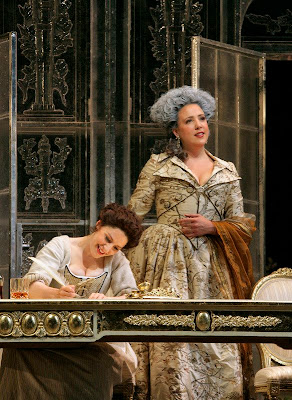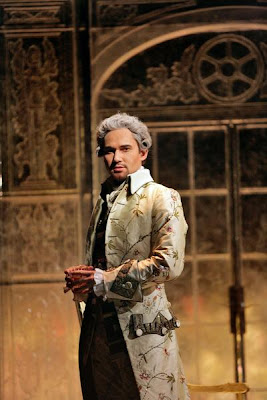For more background information on this opera, see my preview article on Le Nozze di Figaro.

Elizabeth Watts (Susanna, seated) and Susanna Phillips (Countess) in Act III ("Che soave zeffiretto") of Le Nozze di Figaro, sets and costumes by Paul Brown, Santa Fe Opera, 2008 (photo © Ken Howard) |
The first week of full repertory, with all five operas in rotation, began on Monday night at Santa Fe Opera, with the company's new production of Mozart's Le Nozze di Figaro. The earlier curtain time, 8:30 pm, allowed the house to appreciate one of the best reasons to hear opera at John Crosby's outdoor theater, the stunning vista of the Jémez Mountains. With the back of the stage left open to the evening air, behind a floor filled with stems of brightly colored flowers in the design of Jonathan Kent, the New Mexico sunset was at its most beautiful. This production, in more ways than the vista, was about Santa Fe Opera's bread and butter: its extensive history with Mozart, with this opera in particular, and its role as a showcase for the best young singers on their way toward renown.
Jonathan Kent and Paul Brown, the director and set/costume designer who were responsible for the beautiful and intriguing staging of The Tempest two years ago, have created a visually gorgeous production. There is nothing controversial or even particularly daring about it -- the opera is allowed to unfold directly, in an 18th-century setting -- but with a close reading of the libretto the director has helped the singers inhabit the roles and act in natural and well-motivated ways.
Although Mozart and Da Ponte took steps to soften the erotic attraction between the Countess and Cherubino, as found in Beaumarchais's play (transferring some of the Countess's French lines about the page to Susanna, as pointed out by Kristi Brown-Montesano), Kent chose to heighten the signs of the mutual attraction. This became apparent when the Countess's heartrate was visibly racing by the end of "Voi che sapete" and continued throughout the opera. The only part of the staging that missed the mark was Figaro's "Se vuol ballare," where the metaphor of courtly versus peasant dance is introduced (Brown-Montesano mentions that much of Figaro's music is characterized by popular dance rhythms). This would have been a much more subtle evocation of the class conflict that simmers under the surface of Mozart's folle giornata than the clumsy decision to have the chorus of peasants make off with the Count's furniture after the wedding scene.

Mariusz Kwiecień (Count Almaviva) in Act III of Le Nozze di Figaro, sets and costumes by Paul Brown, Santa Fe Opera, 2008 (photo © Ken Howard) |
The high point of the casting was the regal and vocally luxurious Countess of Susanna Phillips, a former SFO apprentice singer who has a burgeoning career. The performance was attractive not least because she was a beautiful young Countess, which helped the impression of her erotic frustration at her husband's inattention, but also for sheer vocal lustre, as in the luscious pianissimo return of the A section in "Dove sono." She also held her composure most impressively in a languid, time-stopping rendition of "Porgi, amor," in spite of an embarrassing bassoon gaffe at the end of the orchestral introduction.
Phillips was matched, in vocal power and attractive stage presence, by her Count, Polish baritone Mariusz Kwiecień, who cut a handsome figure in a floor-length leather coat in the first act. He was also a vicious brute, shamelessly groping Susanna and even brandishing an axe to uncover Cherubino in the Countess's closet in Act II. His good looks and rakish manner helped make the Count believable as a seducer, whose advances Barbarina and even Susanna should really be tempted to accept. The voice was no less smooth and unctuous, with real power as he introduced convincing little embellishments and solid high notes to the part. There was no doubt of the imperious preeminence of this patrician couple over the entire society presented on stage, reinforced by the sets -- of plain IKEA blonde wood for the first act (in Figaro's bedroom), and more Rococo designs of metallic gray for the second and a material like cut glass in the third.

Isabel Leonard (Cherubino, on horse) and Luca Pisaroni (Figaro) in Act I ("Non più andrai") of Le Nozze di Figaro, sets and costumes by Paul Brown, Santa Fe Opera, 2008 (photo © Ken Howard) |
Radiantly beautiful mezzo-soprano Isabel Leonard somehow became a convincingly boyish Cherubino, her vibrato slightly too nervous at first but settling into a more polished sound. It was hard not to think of Luca Pisaroni's sadistic antics in Radamisto when he was singing Figaro, especially as he bullied Cherubino in "Non più andrai," making him sit on a toy horse and subjecting him to other humiliations. Of the conniving supporting trio, Michaela Martens' Marcellina was the most impressive, with a syrupy sound and spiteful wit. Gwynne Howell's Bartolo was amusingly pompous (although with issues at both ends of his range and a less than solid rhythmic sense), and Aaron Pegram's bald-headed Basilio was appropriately vicious (he is a recently graduated SFO apprentice, too). Sadly, both Marcellina's "Il capro e la capretta" and Basilio's "In quegl'anni, in cui val poco" were cut from the fourth act, as they generally are in most productions.
Elizabeth Watts was an impish Susanna, perhaps a little too much toward the cunning soubrette characterization, which undermines her surprising similarity to the Countess (a point explored in Brown-Montesano's book). Her sound was disappointingly small most of the evening, and the vocal disparity with Phillips seemed to be behind her attempt to impersonate the Countess's voice in the fourth act, by comically adding heft to her tone. Intended as a joke, it only made Watts seem underpowered the more, making one wish that the Countess had the top part of the harmonies in "Che soave zeffireto," for example. Watts had all the notes and the comic sense to keep the audience laughing, covering her mouth as she soared up to the high G C in my favorite terzetto ("Susanna or via sortite" -- where she is supposed to be in hiding), but it was hard not to want a more expansive sound in "Deh vieni." Similarly, the Barbarina of apprentice singer Jamie-Rose Guarrine, pretty but a little weak, made one wish the company had asked Anne-Carolyn Bird back this summer.
Other Reviews:
Anthony Tommasini, From Handel, Faithlessness and Devotion (New York Times, August 4)
Scott Cantrell, Elaborate scenery, expressive cast make for a modern 'Figaro' (Dallas Morning News, July 30)
John Stege, Fantastic Figaro (Santa Fe Reporter, July 15)
Kyle MacMillan, Opera's "F's" deserve "A's" in Santa Fe's productions (Denver Post, July 5) |
The score (see the full score from the Neue Mozart-Ausgabe) is so familiar to orchestral musicians and conductors that it can receive short shrift in rehearsal. Kenneth Montgomery had a firm hand at the podium, setting and keeping pleasing tempi and corralling his forces impressively. His only bad judgment was with the exalted act of forgiveness in the fourth act ("Contessa, perdono"), which was so glacially slow that it became like a dirge. The orchestra had its problems, too, with some scandalously imprecise playing from the horns and disappointing, whiny tone from the oboes at times. The subtle sounds of a pianoforte (player uncredited) provided the chords of the recitatives, in a flexible and charming accompaniment.
This production of Le Nozze di Figaro will be repeated at Santa Fe Opera on August 2, 5, 9, 18, and 22.
























































1 comment:
Thank you for the pianoforte comment-- very kind
of you to mention it! James Lesniak (music staff, Santa Fe Opera)
Post a Comment